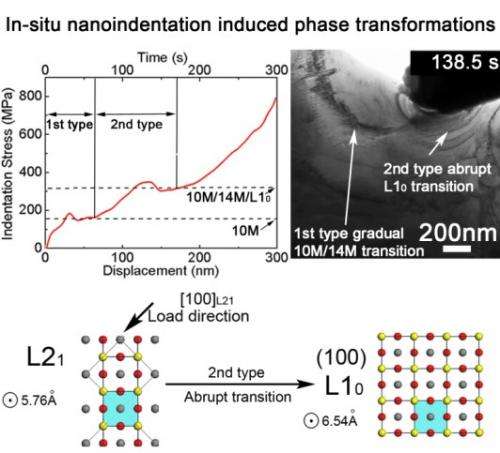Texas A&M University researchers led by Dr. Xinghang Zhang in the Department of Mechanical Engineering have examined stress induced martensitic phase transformations in magnetic shape memory alloys via in-situ nanoindentation technique.
The paper titled "Two Types of Martensitic Phase Transformations in Magnetic Shape Memory Alloys by in-situ Nanoindentation Studies" was published in the March 31 issue (2014) of Advanced Materials. The first author of the paper is Mr. Yue Liu, a Ph.D. candidate in Dr. Zhang's research group.
Ni based magnetic shape memory alloys (MSMAs) have broad applications for actuators and microelectromechanical systems (MEMS) devices. Two-stage stress induced martensitic phase transformation, a widely observed phenomenon in these alloys, is described conventionally as a first stage L21 (austenite)-to-10M/14M (M: modulated martensite) transition, followed by a second stage 14M-to-L10 (tetragonal martensite) transformation at higher stresses.
During their in-situ nanoindentation experiments on Ni54Fe19Ga27 in a transmission electron microscope, Zhang and his graduate student, Mr. Yue Liu, discovered two distinctive types of martensitic phase transformation: A reversible gradual L21-to-10M/14M phase transformation at low stress, and an irreversible abrupt transition from residual L21-to-L10 martensite at higher stress. This study provides new perspectives on understanding stress induced phase transformations in MSMAs.
More information: Liu, Y., Karaman, I., Wang, H. and Zhang, X. (2014), "Two Types of Martensitic Phase Transformations in Magnetic Shape Memory Alloys by In-Situ Nanoindentation Studies." Adv. Mater.. DOI: 10.1002/adma.201400217
Journal information: Advanced Materials
Provided by Texas A&M University























